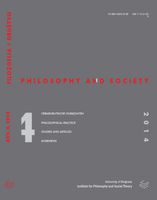On Some Problems of Meaning - Polysemy Between Sense Enumeration and Core Meaning Paradigms
On Some Problems of Meaning - Polysemy Between Sense Enumeration and Core Meaning Paradigms
Author(s): Nikola DobrićSubject(s): Philosophy
Published by: Institut za filozofiju i društvenu teoriju
Keywords: Polysemy; ambiguity; cognition; language philosophy; semantics; prototypically; cognitive semantics; neostructuralism; generative semantics; lexical pragmatics
Summary/Abstract: Polysemy is a semantic phenomenon which occurs when one lexical item has more meanings which can be seen as related to each other. It is to be distinguished from the other extreme pole of ambiguity, homonymy, which occurs when two or more unrelated meanings are by means of an etymologi- cal accident tied to the same orthographic and/or phonological form. Even though polysemy can be considered as a non-issue, since discourse easily solves all of the problems of possible ambiguity for use in everyday language use, accounting for it (in an systematic manner) in terms of how polysemy is represented in the mental lexicon and how to account for the criteria govern- ing the meaning distinctions and the interaction of meanings, for example, is a challenge still not fully met. The paper first gives an overview of the exist- ing theoretical accounts of polysemy which arose over the course of the last two centuries to meet one of the said challenges, namely how polysemy is represented in our minds. The discussion is followed up by a conclusion of the predominant and most plausible theoretical view on multiple meanings stem- ming from the presented philosophical, semantic, and cognitive frameworks and models.
Journal: Filozofija i društvo
- Issue Year: 25/2014
- Issue No: 4
- Page Range: 146-163
- Page Count: 18
- Language: English

